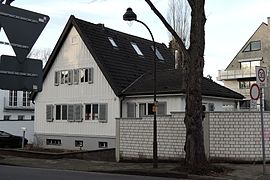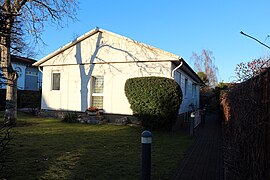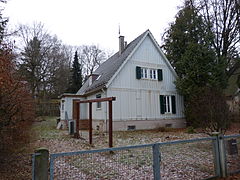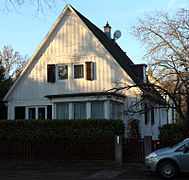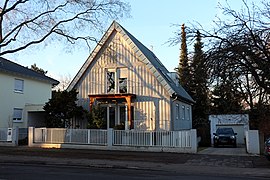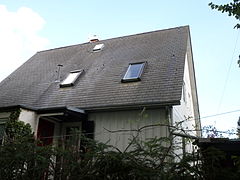MAN steel house
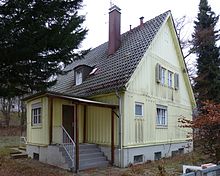
The MAN steel house was a prefabricated house by MAN (Maschinenfabrik Augsburg-Nürnberg) from 1948 to 1953, 230 of which were built worldwide.
history
In the post-war period, the MAN plant in Ginsheim-Gustavsburg , looking for new sales markets for steel structures, began building prefabricated steel houses based on a concept from the 1920s. The MAN steel house was developed at the suggestion of the engineer Heinz Bauer in the main plant in Augsburg and mass-produced in the plant in Mainz-Gustavsburg.
MAN built a model housing estate, in which the senior employees once lived, near the Cramer-Klett settlement in Gustavsburg, which was built in the first quarter of the 20th century in the style of a garden city with historicizing elements. Two different variants were presented there and were to be exported worldwide in large series. The model house settlement showed the basic type with a base area of 8 m × 8 m. Production ceased in 1953 after 230 houses had been built.
Building design
The prefabricated wall elements in the MAN factory were placed on a brick foundation and screwed to a steel frame construction. Between the outer steel sheets and the hardboard inside there is an insulation with glass fiber mats, the insulation value of which was equivalent to an 80 cm thick brick wall, as it was called in advertising brochures at the time. The steel walls, which are protected against corrosion, were painted with oil on the outside.
Outwardly, the architectural design resembled conventional stone buildings: the perforated facades with pitched roofs and the lattice windows with folding shutters were "very simple, but cozy and, despite all the objectivity, something for the German mind", as the architect Hans Schneider did in an expert opinion on behalf of MAN in 1949 had requested. According to the catalog, the basic type could be ordered with different roof pitches. The version with the steeper roof offered space for a habitable attic. Since the roof load was borne by the outer walls, the inner walls could be erected individually.
There were four types of floor plans: 8 m × 8 m, 8 m × 10 m, 8 m × 13 m and 8 m × 16 m. The individual modules of the steel houses were put together on the construction site. The rectangular outer wall panels consisted of 1 mm thick sheet steel with a size of 1 m × 2.51 m and were placed on edge side by side. The inner walls, made of hardboard or plywood, were isolated from the outer steel sheets by glass wool mats. The roof structure was formed from standardized trusses 8 m in length. The floor, which was also insulated with glass wool mats, consisted of tongue and groove planks that were mounted on the modular steel frame construction.
The windows were provided with counterweights and pull-out fly screens and could be lowered to open like in a railroad car. A steel installation wall, in which service and sewage pipes run, was installed between the kitchen and bathroom with the special feature that the bathtub in the narrow bathroom protruded through the wall into the base cabinet of the sink to save space. Closets formed the remaining interior walls. From the perspective of that time, the MAN steel houses turned out to be of high quality: Due to the good thermal insulation, the hot-dip galvanized components and the burned-in paint, there were hardly any corrosion and condensation problems.
costs
A house with simple furnishings cost 18,800 DM at that time , which was comparatively expensive compared to other prefabricated houses, which were offered from 3,500 DM. Including special equipment such as a fitted kitchen, bathroom furnishings and hot water central heating, the MAN steel house cost 30,000 DM, which today corresponds to around 80,000 euros .
Preserved buildings
There are still around 40 MAN steel houses in Germany, the outer walls of which have to be sandblasted and repainted from time to time due to corrosion .
In Ginsheim-Gustavsburg, at Robert-Koch-Strasse 17, 19, 21 and 23, Nürnberger Strasse 20 and 22 and Müngstener Strasse 4, 6, 8 and 10, there is a building-historically significant ensemble with ten listed MAN steel houses that are still inhabited today , including two semi-detached houses. The 2 smallest have an area of 64 m² each, the others are larger. According to a concept of the monument authority, in accordance with the Hessian Monument Protection Act , all may be provided with modern extensions. The historical building fabric and contemporary architecture must be clearly juxtaposed. The ten houses are part of the route of industrial culture Rhein-Main Mainspitze .
Four houses have been preserved in Augsburg-Oberhausen . You are at Sebastianstraße 29d, e, f and i not far from the MAN factory premises in the city district of Rechts der Wertach . Another MAN steel house is at Bergstrasse 9 from Stadtbergen - Leitershofen .
A MAN steel house from 1948 was relocated from Wendelstein-Nerreth in Central Franconia near Nuremberg to the Franconian Open Air Museum Bad Windsheim in 2011 .
In Nürnberg-Laufamholz , three houses from the year of construction 1951 have been preserved, which are listed as architectural monuments in the Bavarian list of monuments. They are located at Laufamholzstraße 197, 199 and 201, two similar houses from 1952, also architectural monuments , are at Bothmerstraße 43 and 45 in Nuremberg-Mögeldorf . Another listed building from 1951 is not far away, at Tannenweg 28 in Schwaig near Nuremberg . A steel house is still in Düsseldorf-Kaiserswerth .
A steel house is in Bergisch Gladbach - Frankenforst and was listed as a historical monument in 2019.
In the Upper Town of Mainz there were four MAN steel houses, three of which have been preserved at An der Goldgrube 33, 35 and 43 (status: 2013). A MAN steel house with a low roof is located at Liebermannstrasse 12 in Cologne-Müngersdorf . Another listed building is located at Friedrich-Ebert-Straße 75 in Oppenheim .
Two listed and inhabited MAN steel houses from 1951 are located in Karlsruhe at Langen Strasse 169 and Edelsheimstrasse 7a.
In Stuttgart - Sillenbuch , at Oberwiesenstrasse 8, there was a MAN steel house that was threatened with demolition until mid-2016, whose cultural monument property was only examined and determined when the sale of the property, the planning of the new building and the financing had already been initiated. With the support of the state of Baden-Württemberg, a solution for the preservation of the cultural monument and its public use was nevertheless found: After it was relocated to the grounds of the Hohenloher Open Air Museum in Schwäbisch Hall-Wackershofen in 2017 and the associated renovation, restoration and conservation of all parts of the building, it presented itself since 2019 the “dream of living 1952” as a publicly accessible museum building.
Hildegundisallee 41, Meerbusch-Büderich
See also
- Steel House (Dessau)
- Düsseldorf steel house settlements
- Hoesch bungalow
- Copper house
- Center Le Corbusier
literature
- Michael Bermeitinger: A work adventure made of steel - at the end of the 1940s the Gustavsburg plant produced prefabricated houses in Allgemeine Zeitung Mainz, p. 14 of July 25, 2018
Web links
- Website of a MAN steel house owner in Mainz (Goldgrube 43) ; online on the Internet: July 25, 2018
Individual evidence
- ↑ a b Enrico Santifaller: Highlights - Middle Rhine. (PDF; 2.7 MB)
- ^ Jörg Heimeshoff: Rheinische Kunststätten. Architecture of the fifties of the 20th century in Düsseldorf - secular buildings without schools and bridges (issue 360) . Schwann, Düsseldorf 1990, ISBN 3-88094-671-X , p. 6 .
- ↑ John Kottjé: Apartment houses made of steel: Contemporary architecture for light-flooded rooms. ( Memento of the original from December 24, 2013 in the Internet Archive ) Info: The archive link was inserted automatically and has not yet been checked. Please check the original and archive link according to the instructions and then remove this notice. (PDF; 14.6 MB) Deutsche Verlags-Anstalt Munich, ISBN 978-3-421-03453-3 . Page 12 of the online excerpt.
- ↑ a b c Ulrich von Mengden: Ten MAN steel houses from 1948 still stand in Gustavsburg. ( Memento of the original from February 5, 2012 in the Internet Archive ) Info: The archive link was automatically inserted and not yet checked. Please check the original and archive link according to the instructions and then remove this notice. Main peak from December 22, 2011.
- ↑ Nina Schoel: Practical Work 4: Mobile and Modular Buildings. ( Memento of the original from December 24, 2013 in the Internet Archive ) Info: The archive link was inserted automatically and has not yet been checked. Please check the original and archive link according to the instructions and then remove this notice.
- ↑ Rudolf Maria Bergmann: Private happiness in series: A prefabricated house from the post-war period in the Franconian Open Air Museum Bad Windsheim. Bavarian State Newspaper of April 27, 2012.
- ^ Matthias Ludwig: Mobile architecture. Stuttgart, Deutsche Verlags-Anstalt, 1998. p. 71.
- ↑ Achim Bergmann: Those who sit in the steel house are comfortable: visiting a Nuremberg family - the museum now has a MAN building. September 21, 2011.
- ^ Michael Scheffold: A steel house in the museum. In: Stahlmarkt No. 12 2008. Düsseldorf 2008, p. 63f.
- ↑ List of monuments for Nuremberg (PDF) at the Bavarian State Office for Monument Preservation
- ↑ List of monuments for Schwaig near Nuremberg (PDF) at the Bavarian State Office for Monument Preservation
- ^ Renovation of the steel house in Düsseldorf-Kaiserswerth. ( Memento of the original from July 25, 2014 in the Internet Archive ) Info: The archive link was inserted automatically and has not yet been checked. Please check the original and archive link according to the instructions and then remove this notice.
- ↑ Urban Development and Planning Committee - 02.26.2019 - 7.30 p.m. -7.53 p.m. Retrieved February 27, 2019 .
- ↑ Database of cultural monuments: Lange Str. 169, Rüppurr. Retrieved May 11, 2018 .
- ↑ Database of cultural monuments: Edelsheimstr. 7a, Oststadt. Retrieved May 11, 2018 .
- ^ Building research in Baden-Württemberg: Stuttgart, Oberwiesenstrasse 8
- ↑ Eveline Blohmer: construction projects in Sillenbuch: criticism of construction of two pages. Stuttgarter Nachrichten, April 7, 2016.





